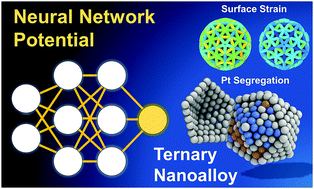First-principles database driven computational neural network approach to the discovery of active ternary nanocatalysts for oxygen reduction reaction†
Abstract
An elegant machine-learning-based algorithm was applied to study the thermo-electrochemical properties of ternary nanocatalysts for oxygen reduction reaction (ORR). High-dimensional neural network potentials (NNPs) for the interactions among the components were parameterized from big dataset established by first-principles density functional theory calculations. The NNPs were then incorporated with Monte Carlo (MC) and molecular dynamics (MD) simulations to identify not only active, but also electrochemically stable nanocatalysts for ORR in acidic solution. The effects of surface strain caused by selective segregation of certain components on the catalytic performance were accurately characterized. The computationally efficient and precise approach proposes a promising ORR candidate: 2.6 nm icosahedron comprising 60% of Pt and 40% Ni/Cu. Our methodology can be applied for high-throughput screening and designing of key functional nanomaterials to drastically enhance the performance of various electrochemical systems.



 Please wait while we load your content...
Please wait while we load your content...